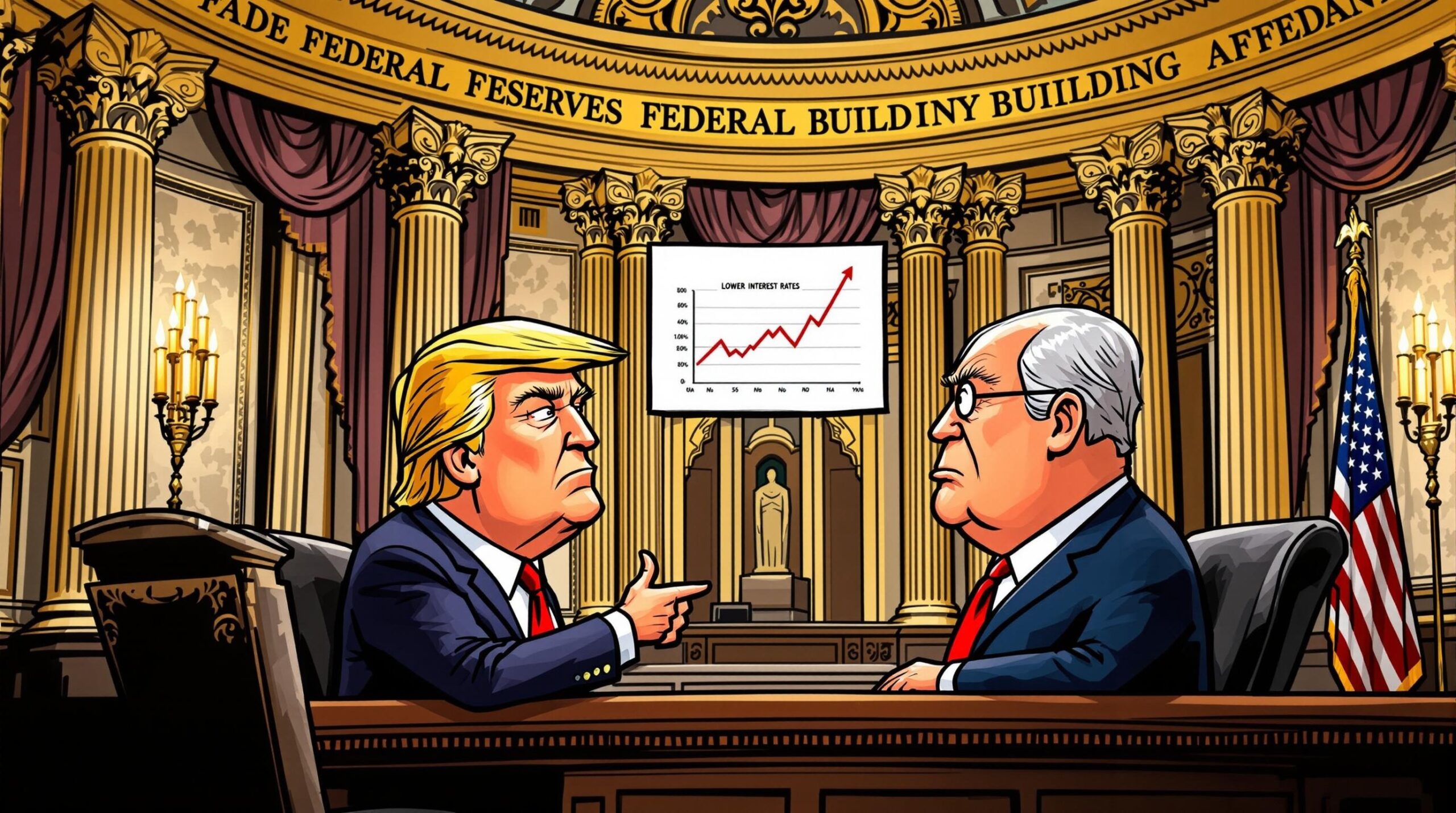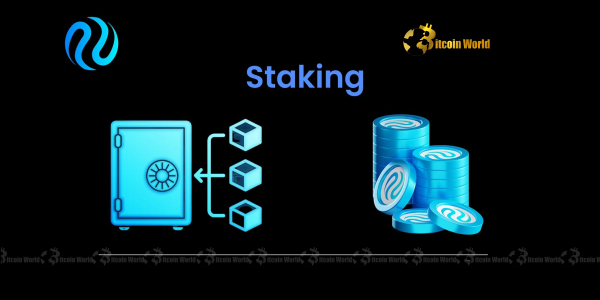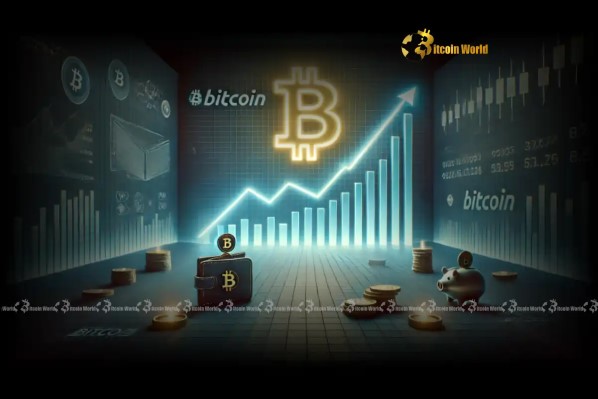BitcoinWorld

Donald Trump Fed: Bold Demand for Lower Interest Rates Unleashes Economic Debate
The intersection of politics and monetary policy often sends ripples through global markets, and for cryptocurrency enthusiasts, understanding these dynamics is paramount. When Donald Trump Fed interactions become public, especially regarding critical issues like interest rates, the implications can be profound, shaping everything from bond yields to Bitcoin’s volatility. Recently, a direct encounter between former President Donald Trump and Federal Reserve Chairman Jerome Powell has ignited fresh debate, highlighting the persistent tension between political desires and central bank independence. This pivotal meeting at the Federal Reserve headquarters saw Trump express a clear preference for lower interest rates, a move that could significantly influence the economic landscape and, by extension, the crypto market.
What Sparked Donald Trump’s Fed Visit and His Demands?
In a move that underscored his characteristic directness, former U.S. President Donald Trump Fed Chairman Jerome Powell at the Federal Reserve headquarters with a clear message: he wants lower interest rates. This encounter, as reported by the Walter Bloomberg economic news account on X, was more than just a courtesy call; it was a direct expression of presidential economic philosophy. Upon his arrival, Trump reportedly questioned the substantial $3.1 billion cost of renovating the Fed headquarters, to which Powell allegedly responded with a simple shake of his head. This exchange quickly escalated, with Trump remarking that he generally fires managers of projects that exceed their budgets, setting a confrontational tone for the subsequent discussion on monetary policy. This visit reignited discussions about the delicate balance between executive influence and the Fed’s mandated independence, a principle designed to shield monetary policy from short-term political pressures and ensure long-term economic stability.
The Crucial Call for Lower Interest Rates: Why It Matters for Donald Trump Fed Policy
President Trump’s demand for lower interest rates isn’t merely a casual suggestion; it represents a significant economic stance with far-reaching implications for the U.S. and global economies. Historically, lower interest rates make borrowing cheaper for businesses and consumers, encouraging investment, spending, and economic growth. This can lead to increased job creation and a more vibrant economic environment. For instance, businesses might expand operations, consumers might take out more loans for homes or cars, and the government’s cost of servicing its national debt could decrease. However, they also carry risks, such as fueling inflation if the economy overheats, or creating asset bubbles as investors chase higher returns in a low-yield environment.
For the cryptocurrency market, the implications are particularly interesting. Periods of lower interest rates and increased liquidity in the financial system have often coincided with increased investor appetite for riskier assets, including cryptocurrencies. When traditional safe-haven returns, like those from bonds or savings accounts, diminish, investors tend to seek higher yields elsewhere. This “search for yield” can drive capital into alternative assets like Bitcoin and Ethereum. Therefore, the future direction of Donald Trump Fed policy, especially concerning rates, becomes a key factor for crypto investors to watch. A consistent push for lower rates could potentially create a more favorable macroeconomic backdrop for digital assets, making alternative investments more appealing as the opportunity cost of holding cash increases.
Navigating the Budget Battles: A Key Aspect of Donald Trump Fed Discussions
Beyond the interest rate debate, the discussion surrounding the Federal Reserve’s $3.1 billion headquarters renovation cost added another layer of intrigue to the Donald Trump Fed meeting. Trump’s questioning of this expenditure and his subsequent comment about firing managers of over-budget projects highlight a broader theme of fiscal scrutiny that often characterizes his approach to governance. This perspective, while applied to building costs, reflects a mindset that could influence broader economic policy. For example, a focus on reducing government spending or ensuring efficiency in public projects could align with a desire for a more streamlined economy. It also serves as a reminder that even seemingly bureaucratic details can become points of political contention, reflecting a populist appeal to fiscal responsibility.
The Fed’s operational budget, while separate from its monetary policy decisions, is still subject to public and political scrutiny. A $3.1 billion renovation project, especially for a public institution, can easily become a lightning rod for criticism, particularly from those advocating for tighter government spending. Trump’s comments underscore a desire for accountability and efficient use of taxpayer money, even if the Fed primarily funds itself through its operations rather than direct congressional appropriations. This particular exchange paints a vivid picture of Trump’s managerial style and his readiness to challenge established norms, even within institutions designed for independence.
The Delicate Balance: Understanding Federal Reserve Independence and Donald Trump Fed Interactions
The Federal Reserve operates with a significant degree of independence from political influence, a design enshrined in its structure to allow it to make monetary policy decisions based on economic data rather than short-term political cycles or election considerations. This independence is crucial for maintaining stability and credibility in financial markets, preventing policies that could lead to hyperinflation or economic instability due to political expediency. However, presidential pressure on the Fed is not unprecedented; various administrations have, to varying degrees, expressed their preferences regarding monetary policy. Yet, Trump’s direct and public demands have often been more pronounced and frequent than those of his predecessors, pushing the boundaries of traditional decorum.
The interaction between Donald Trump Fed Chairman Powell underscores this ongoing tension. Powell, appointed by Trump himself, has often had to navigate a challenging path, balancing his commitment to the Fed’s independent mandate with the public demands of the executive branch. This dynamic is a critical aspect of U.S. economic governance, influencing everything from bond yields to the perceived stability of the dollar, and indirectly, the broader financial landscape that impacts assets like cryptocurrencies. The integrity of the Fed’s independence is vital for investor confidence, as it signals that monetary policy will be guided by economic fundamentals rather than political whims, providing a more predictable environment for long-term planning and investment.
Potential Economic Impacts and Market Reactions to Donald Trump Fed Policy Shifts
Should the Federal Reserve heed calls for lower interest rates, or even just face persistent pressure that subtly influences its decisions, the economic ripple effects could be substantial. Lower rates could stimulate borrowing and investment, potentially boosting economic growth and employment. However, they also carry risks, such as exacerbating inflation, encouraging excessive risk-taking, or creating asset bubbles in real estate or equity markets. For markets, including the volatile cryptocurrency space, such shifts in monetary policy expectations are closely watched. Investors might interpret a dovish Fed stance as a signal to move into riskier assets, potentially benefiting cryptocurrencies as the yield on safer investments becomes less attractive.
Conversely, any perceived erosion of the Fed’s independence could introduce uncertainty, leading to market volatility. A central bank seen as bowing to political pressure might lose credibility, which could have detrimental effects on currency stability and investor confidence. The direct nature of Donald Trump Fed discussions ensures that these potential shifts remain a central topic for analysts and investors alike, as they gauge the future trajectory of the U.S. economy and its global implications. Understanding these dynamics is crucial for making informed investment decisions, especially in asset classes highly sensitive to liquidity and interest rate environments.
The Dual-Edged Sword of Lower Interest Rates
While the prospect of lower interest rates often sounds appealing, especially to borrowers and those seeking to stimulate economic growth, it’s essential to understand the full spectrum of their effects. Here’s a quick look at the common arguments:
| Potential Benefits | Potential Risks |
|---|---|
| Stimulates economic growth by encouraging borrowing and spending. | Can lead to higher inflation if demand outstrips supply. |
| Reduces the cost of debt for businesses and consumers. | May encourage excessive risk-taking and asset bubbles (e.g., in real estate, stocks, or even cryptocurrencies). |
| Can make exports more competitive by weakening the domestic currency. | Reduces returns on savings accounts and fixed-income investments, hurting savers. |
| Increases the attractiveness of riskier assets like stocks and cryptocurrencies. | Could lead to over-indebtedness if borrowing becomes too easy. |
Key Considerations for Investors:
- Interest Rate Sensitivity: Understand how changes in interest rates can affect different asset classes, particularly cryptocurrencies, which often thrive in environments of abundant liquidity.
- Inflationary Pressures: Monitor inflation data closely, as lower rates can sometimes contribute to rising prices, impacting purchasing power and real returns.
- Central Bank Independence: Keep a vigilant eye on the political discourse surrounding the Fed. Its perceived independence is a cornerstone of market stability and can influence investor confidence.
- Global Economic Interconnectedness: Recognize that U.S. monetary policy has profound global ramifications, impacting international trade, capital flows, and the strength of other currencies, which in turn affects global markets.
In conclusion, the recent interaction between former President Donald Trump and Federal Reserve Chairman Jerome Powell regarding interest rates and budget oversight is a potent reminder of the intricate relationship between political leadership and independent economic institutions. Trump’s direct demands for lower interest rates, coupled with his critique of the Fed’s renovation costs, highlight his consistent approach to economic policy, often prioritizing growth stimulation and fiscal accountability. While the Federal Reserve maintains its independence, such high-profile encounters inevitably shape public discourse and market expectations. For those navigating the complexities of the financial world, particularly in the rapidly evolving cryptocurrency space, understanding these dynamics is not just academic; it’s essential for informed decision-making. The ongoing dialogue between political power and monetary policy will continue to be a defining feature of the economic landscape, with profound implications for investors, the broader economy, and the future trajectory of digital assets.
Summary of Key Takeaways:
- Direct Presidential Pressure: Donald Trump’s visit to the Fed headquarters involved direct demands for lower interest rates and scrutiny of renovation costs, signaling a hands-on approach to economic policy.
- Monetary Policy Implications: Lower rates could stimulate the economy but also carry inflation risks, impacting asset classes like cryptocurrencies by making them potentially more attractive in a low-yield environment.
- Fed Independence Under Scrutiny: The interaction highlights the ongoing tension between political desires and the Federal Reserve’s crucial independence, a cornerstone of stable financial markets.
- Economic and Market Sensitivity: Markets closely watch such interactions for signals on future monetary policy, influencing investor sentiment, asset allocation, and the overall economic outlook.
- Fiscal Scrutiny: The debate over the Fed’s renovation budget underscores a broader theme of accountability in public spending, reflecting a consistent aspect of Trump’s economic philosophy.
Frequently Asked Questions (FAQs)
- Q1: What was the main purpose of Donald Trump’s visit to the Federal Reserve?
- A1: The primary purpose of former President Donald Trump’s visit was to convey his desire for the Federal Reserve to lower interest rates, which he believes would further stimulate the U.S. economy. He also questioned the cost of the Fed’s headquarters renovation.
- Q2: Why does Donald Trump want lower interest rates?
- A2: Donald Trump has consistently advocated for lower interest rates, believing they make borrowing cheaper for businesses and consumers, thereby encouraging investment, spending, and overall economic growth. He often views higher rates as a hindrance to economic expansion.
- Q3: How does the Federal Reserve maintain its independence from political influence?
- A3: The Federal Reserve is designed to be an independent central bank, making monetary policy decisions based on economic data rather than short-term political pressures. Its Board of Governors serves staggered terms, and its funding comes from its own operations rather than congressional appropriations, aiming to insulate it from direct political control.
- Q4: What are the potential impacts of lower interest rates on the cryptocurrency market?
- A4: Lower interest rates can make traditional safe-haven assets less attractive, leading investors to seek higher returns in riskier assets, including cryptocurrencies. They can also increase overall market liquidity, which often benefits speculative assets. However, this relationship is complex and influenced by many other factors.
- Q5: What was the controversy regarding the Fed’s headquarters renovation cost?
- A5: President Trump questioned the reported $3.1 billion cost of renovating the Federal Reserve headquarters, expressing concern over the budget. He made a remark about firing managers of projects that go over budget, highlighting his focus on fiscal accountability.
Did this deep dive into the Donald Trump Fed interaction and its economic implications shed light on crucial market dynamics for you? Share this article with your network on social media to spark further discussion and help others understand the complex interplay between politics, monetary policy, and the financial markets!
To learn more about the latest crypto market trends, explore our article on key developments shaping Bitcoin and Ethereum price action.
This post Donald Trump Fed: Bold Demand for Lower Interest Rates Unleashes Economic Debate first appeared on BitcoinWorld and is written by Editorial Team





